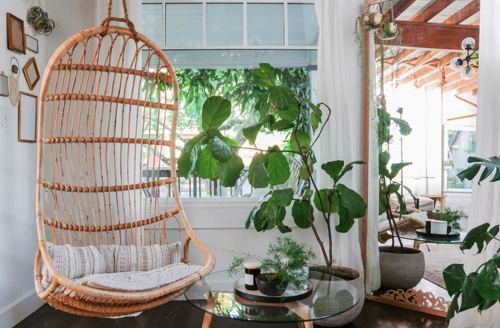Our editors independently select these products. Making a purchase through our links may earn Well+Good a commission
Help Your Plant Branch Out by ‘Notching’ To Encourage New Growth
Plant notching is simply putting a small cut in the trunk of the plant to encourage the growth of branches. Here's how to do it correctly.

Sometimes houseplants need a little bit of encouragement to reach their full potential. Think of the fiddle leaf fig: Left to its own devices, it grows straight up without forming any branches. Liam Heeks, shop manager at Brooklyn plant shop Tula House, says notching your plant will help it branch out. Plant notching is simply putting a small cut in the trunk of a plant.
Experts in This Article
plant expert and shop manager at Tula House
“Plant notching is a method of encouraging new growth on plants, forcing plants to branch without taking any height off the specimen,” says Heeks. “It is natural for plants to grow upwards, fighting to get sunlight in the wild and in our apartments. With notching, it will help encourage outward growth, versus upward, creating a fuller and bushier specimen.”
Heeks says that many plants can benefit from notching, but it is most commonly practiced on ficus trees including: rubber plants ($16), fiddle leaf figs ($54), and other rubber tree varieties. Houseplant enthusiasts have started also using this method on other plants such as monsteras ($11), notes Heeks. “With both ficus trees and vining tropicals, they will need a splint for support,” he says. “We recommend using bamboo sticks ($16) and garden tape ($4).”
Here’s five things to know about fiddle leaf fig care:
Notching is most successful with mature plant. “I recommend starting to make cuts when the plant is 2.5 to 5 feet tall. A plant of this size would most likely be in a 6″ pot or larger,” says Heeks. “On a smaller plant, you can try a few notches (two to three), but I would recommend waiting until the plant is more mature. It would be beneficial for the plant to develop a strong base and root system before trying to initiate additional branching.”
The best time of year to notch a plant is during its growing season. “When it is actively growing,” says Heeks, “your plant will be able to best recover from the stress, and push out new growth.” If you prune or notch your plant during the winter months, the plant may only put out one new branch. And while notching helps to promote growth, not all notches will be successful. To save yourself from disappointment, Heeks says to make about six cuts at a time if your plant is large enough. “With six cuts, you may have results of two to three new branches,” he says.
How to do plant notching correctly
1. Find the nodes
“To identify a node, look at the base of a bud, leaf or branch; they are always attached to a node,” says Heeks. “Even when you cannot see any leaves or buds, look for where a leaf fell away and left a scar. To practice notching you will be cutting in between the nodes.”
2. Pick your spot
“Start by deciding where you want to encourage growth by choosing a spot or spots between two nodes,” says Heeks.
3. Make your cuts with a sharp knife
“Using a sharp non-serrated knife, make an angled cut about one-quarter of the way through the trunk,” says Heeks. “If you go too deep, more than one-third of the way through, you may risk the plant stalk breaking. If you do not cut deep enough, or your knife is not sharp enough, you will create a scar versus encourage branching.”
When cutting, Heeks says to pay attention to the direction the node is facing. “The direction of the node will determine the direction of the branch growth,” he says.
4. Mark your cut
“You can mark the area with a small piece of ribbon or string to keep track of the growth,” he says.
5. Watch and wait
“It will take anywhere from a few weeks to a couple months to see new growth come from the notching,” says Heeks. “We usually see results in about a month.”
Oh hi! You look like someone who loves free workouts, discounts for cult-fave wellness brands, and exclusive Well+Good content. Sign up for Well+, our online community of wellness insiders, and unlock your rewards instantly.
Sign Up for Our Daily Newsletter
Get all the latest in wellness, trends, food, fitness, beauty, and more delivered right to your inbox.
Got it, you've been added to our email list.








